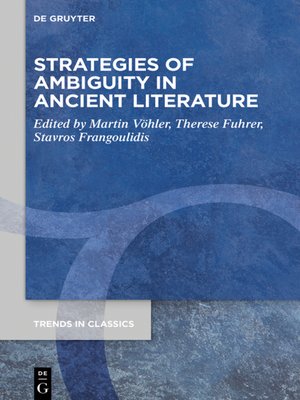Strategies of Ambiguity in Ancient Literature
ebook ∣ Trends in Classics--Supplementary Volumes
By Martin Vöhler

Sign up to save your library
With an OverDrive account, you can save your favorite libraries for at-a-glance information about availability. Find out more about OverDrive accounts.
Find this title in Libby, the library reading app by OverDrive.



Search for a digital library with this title
Title found at these libraries:
| Loading... |
Ambiguity in the sense of two or more possible meanings is considered to be a distinctive feature of modern art and literature. It characterizes the "open artwork" (Eco) and is generated by "disruptive tactics" (Wellershoff) and strategies to engender uncertainty. While ambiguity is seen as a "paradigm of modernity" (Bode), there is skepticism regarding its use in the pre-modern era. Older studies were dominated by the conviction that there was a lack of ambiguity in pre-modernity because, according to the rules of the "old rhetoric", ambiguity was seen as an avoidable error (vitium) and a violation of the dictate of clarity (perspicuitas).
The aim of the volume is to re-examine the putative "absence of ambiguity" in the pre-modern era. Is it not possible to find clear examples of deliberately employed (intended) ambiguity in antiquity? Are the oracles and riddles, the Palinode of Stesichoros and Socrates (Phaedrus), the dissoi logoi of rhetoric, the ambiguities of the tragedies all exceptions or do they not indicate a distinct interest in the artistic use of ambiguity?
The presentations of the conference, which will include scholars from various philologies, will combine a recourse to theoretical concepts of intended ambiguity with exemplary analyses from the field of pre-modern art and literature.






